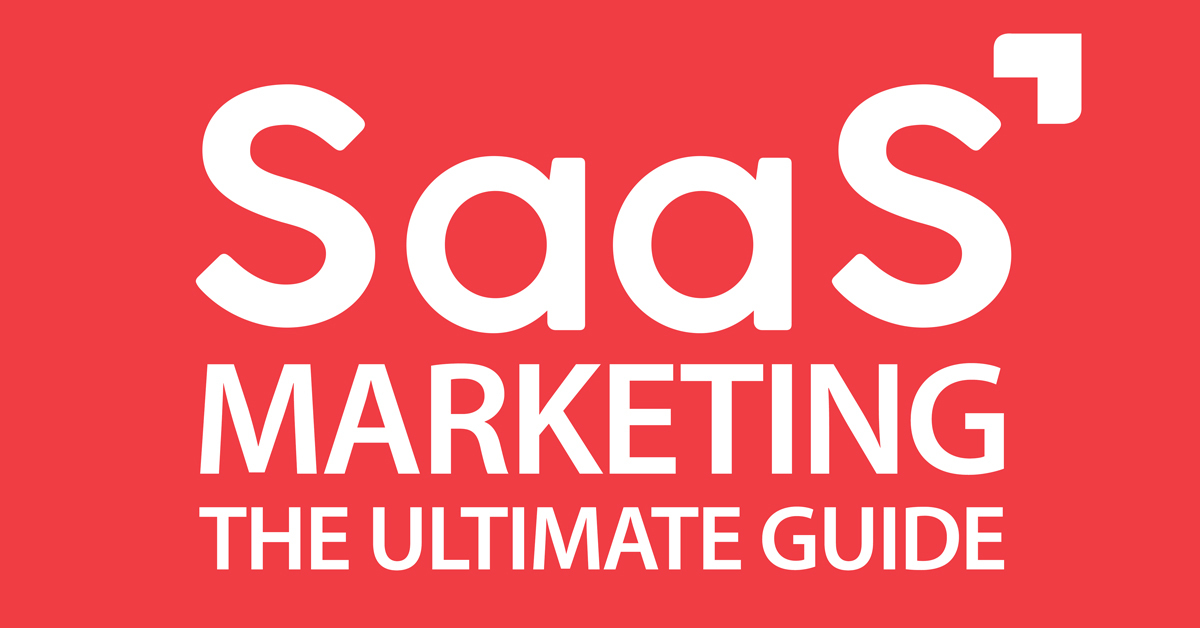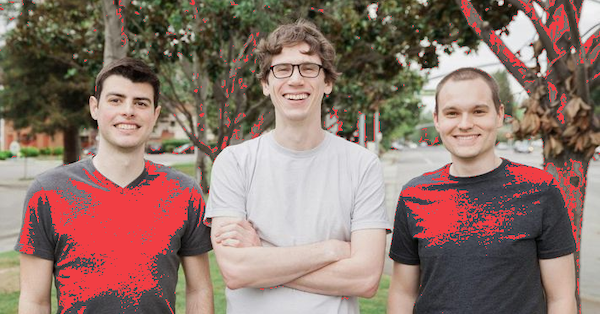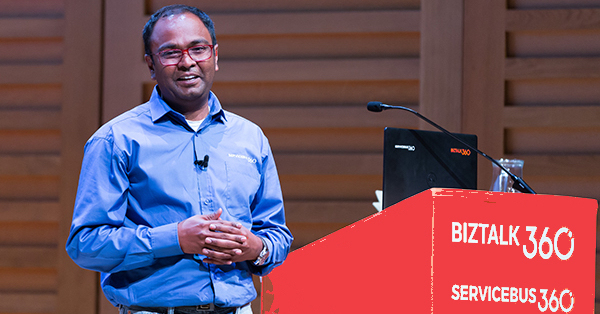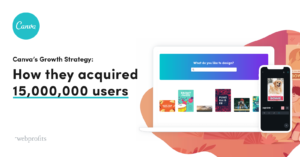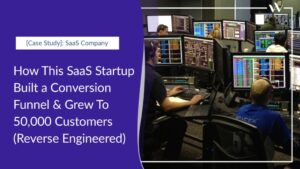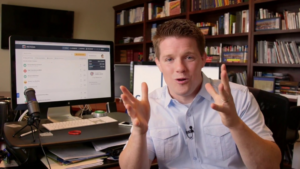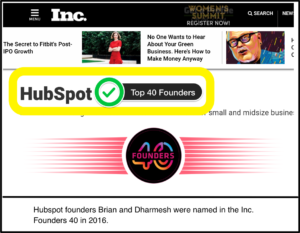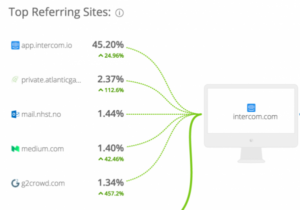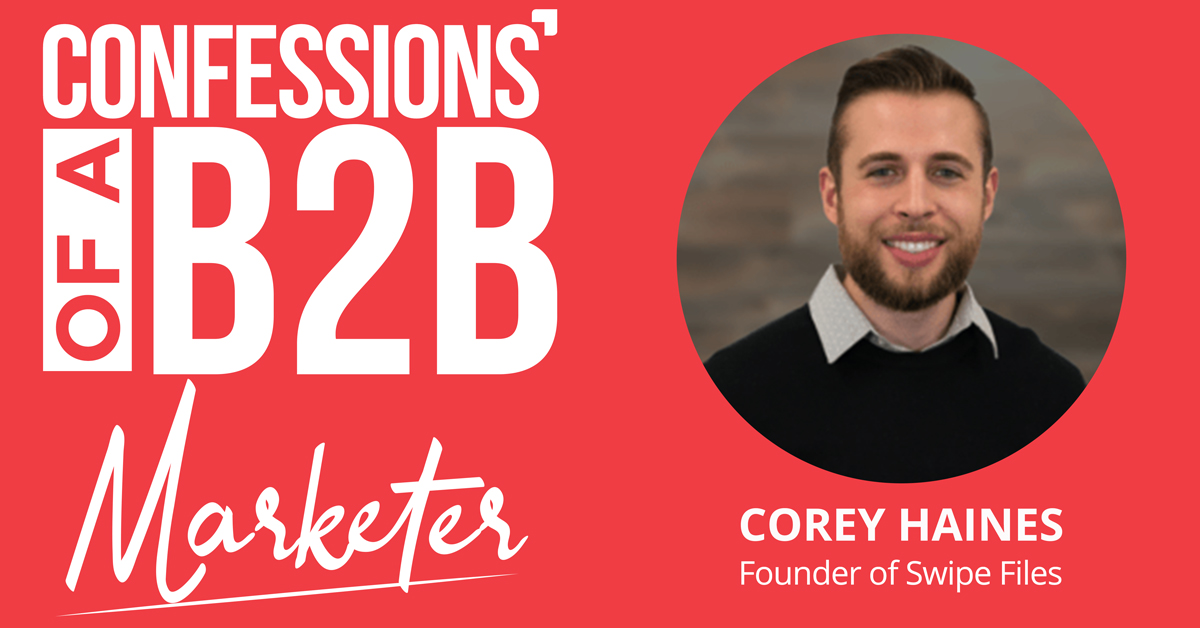Alright.
Welcome to what we believe to be the most comprehensive guide to SaaS marketing that exists on the internet.
I’ve been in the online marketing game for seven years now, with approximately five of those spent marketing software… and I still feel like I’m scratching the surface.
That said, since writing for #saashacker and SaaS Marketer over the past two years I feel as though things are finally starting to make a little more sense. I’ve studied the growth of over 150 SaaS businesses, and this article shares my core findings…
This is a BIG post with multiple sections so please work through the sections that are most relevant to you.
And as you do… remember that the way you get good any ANYTHING is to try and fail first. So if you close this tab without planning to take some kind of action towards improving your SaaS marketing then we have done something wrong and you will be wasting your time.
So grab a strong black coffee and your notepad, because you’re going to need them 😉
What is SaaS marketing?
SaaS marketing – The ‘term’ is often associated with a plethora of questions, including ‘What is SaaS marketing?’ Is SaaS marketing difficult?’ ‘Is SaaS marketing different from regular marketing?’ If yes, ‘How?’
Let’s try to find out the answer to all these questions and in the process help unveil secrets behind to growing a SaaS business.
SaaS marketing is the process of promoting the services offered by SaaS companies that primarily focuses on promoting and selling subscription-based products. When we talk about SaaS aka Software as a Service, we refer to cloud-based applications with regular updates and added functionality.
Let’s be very clear about what we are selling here…
Just like ANY business, B2B or B2C we are selling an desired end result. It doesn’t really matter that we enable our customers to get this end result with a pill, service delivered by humans or by microchips. This therefore helps to answer the question: “is SaaS marketing different?”… from this perspective, no it isn’t.
But from another perspective…
SaaS products don’t have a physical form and therefore marketing them can be more challenging compared to marketing something that people can touch, see and smell.
Marketers must understand that SaaS companies are not targeting customers to sell an application but to subscribe to the services that they are selling. Thus, the onus is on the SaaS marketing team to prove to current as well as potential customers that the services they are opting in for are worth their subscription fees.
Though every aspect of marketing is unique, SaaS marketing needs a more customized approach. As marketers, you need to understand the intricacies of a subscription-based business while developing a SaaS marketing plan.
Remember, you aren’t selling a product, but a recurring service. Therefore you are not getting full payment upfront and may only break even on a customer after 6-24 months after the subscribe. Thus your focus should be on increasing the lifetime value of each customer by ensuring the retain over a longer period of time.
In summary, my favorite definition of marketing is:
To educate with a view to sell something
And therefore, SaaS marketing is simply the process of educating a market towards the sale of your SaaS product.
Why is SaaS marketing different?
This is not black and white… SaaS marketing has much in common with other form of marketing, but there are also very important considerations that SaaS marketers must take into account before embarking upon new campaigns.
What are these considerations?
Let’s see…
In SaaS marketing, you aren’t selling a product, you are selling software. But that’s not all, remember SaaS stands for: software as a service. You’re not only selling software, you’re selling a service.
Most people in SaaS think that customers buy their software… they don’t. As discussed above, they invest in you because they want to achieve a desired end result. And they are most likely to achieve this result through your software AND service.
What’s the difference between marketing software and a service?
Well there isn’t actually that much difference. You are still selling a brighter future where your customer achieves their desired end result. And if you think about it, the customer doesn’t care if you have humans or microchips doing the work.
Neil Patel of UberSuggest knows this:
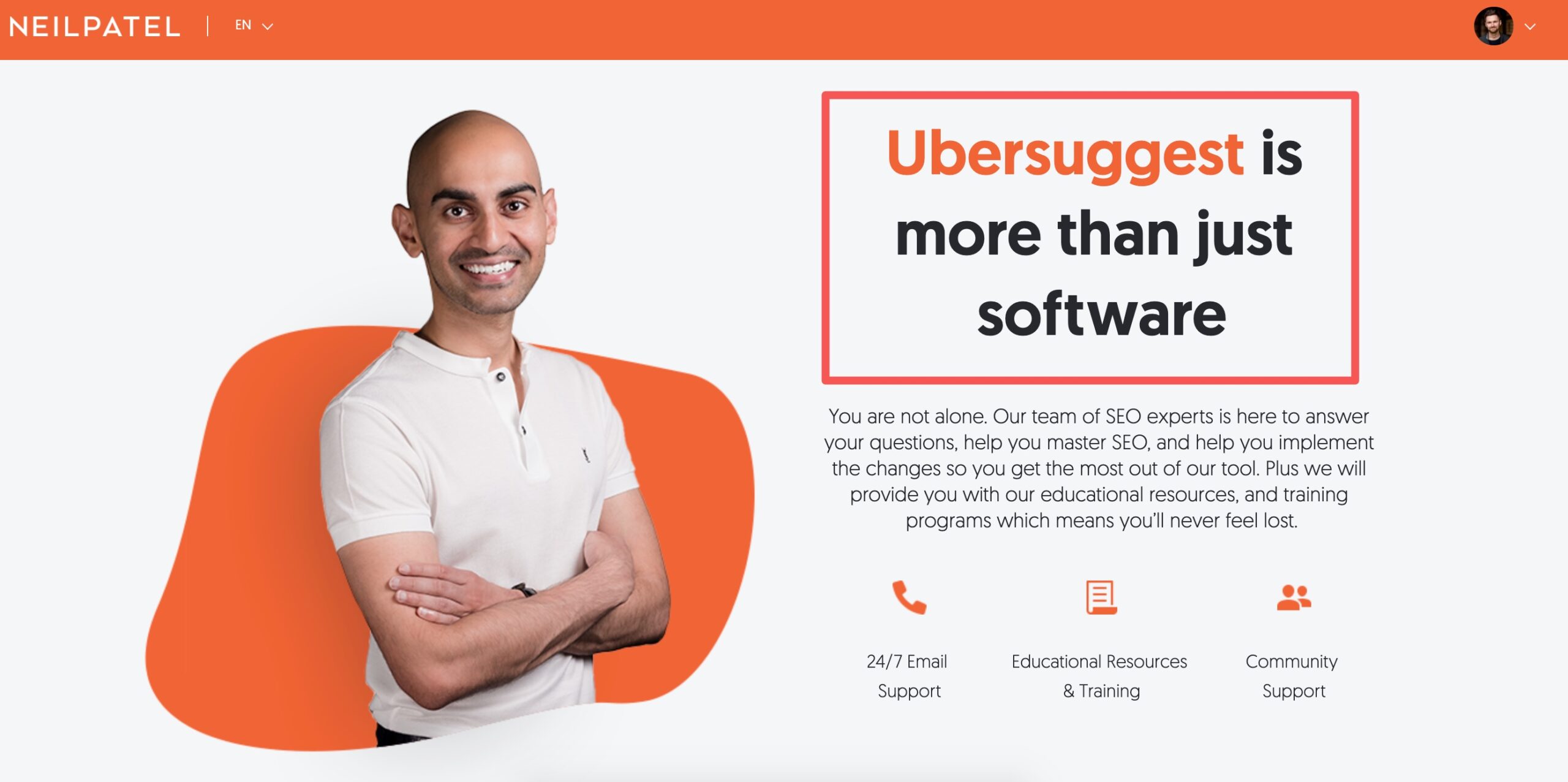
Neil is highlighting the fact that when you subscribe to Ubersuggest, yes you get the software… but actually there is massive value in the knowledge of the people that build the software and help customer use it.
Be sure to highlight your quality of service when marketing your SaaS.
Let’s now tackle a couple more considerations:
1. The ability to offer a free trial or freemium model
With the low marginal cost associated with operating microchips, SaaS businesses are able to offer software completely free for a specified time period (a free trial) or indefinite amount of time with limited functionality (freemium).
Service or product businesses are unlikely to be able to do this, due to the costs associated with operating people.
Providing a free trial or freemium model enables prospects to learn more about your software and service prior to making the investment, reducing risk on their side.
2. The heightened importance of unit economics
The subscription charging model increases the importance that you… as a SaaS marketer understand the customer acquisition cost and lifetime value of your business.
Let’s say you pay $500 to acquire a customer (blended across all channels) on a $50 per month subscription.
Your customer must stay for ten months in order for you to return the cash expended to acquire them and they may need to stay for twelve months to become profitable.
If you were selling a product or service, this calculation would be much simpler as you would just incorporate this acquisition cost into your pricing. You may charge $1,000, knowing that you would most likely be profitable if the customer purchases at this price point.
An ideal ratio of these metrics… LTV:CAC is 3:1, this implies that the lifetime value of a customer should be three times more than the cost of acquiring them.
In SaaS, even if the customer acquisition cost (CAC) is high, keeping that customer around longer can still make the ratio work. In a competitive industry, if you cannot decrease CAC, you can very well achieve a better ratio by increasing the LTV, highlighting the importance of a great customer service.
In summary, marketing a SaaS product is relatively similar to marketing a service except that you need to:
- Have a very strong grasp on LTV/CAC
- Develop awesome support to increase LTV
- Understand that buyers want your software AND service
- Leverage the low marginal cost of computing power to allow prospects to realize value through a free trial or freemium before investing
What are the key SaaS marketing metrics?
The only way you can tweak and improve your SaaS marketing is by having a solid understanding of your current reality.
How is this done?
By tracking the right metrics.
The success of your SaaS marketing plan and resulting strategies are dependent on the KPIs that you track and optimize.
If you are the god of marketing, and everything you try ALWAYS works the first time then maybe you don’t need to track anything: this section is for everyone else…
You can track a whole host of different metrics, we advise focusing on these:
Total site sessions
A site session is simply someone visiting your website, a ping from their server to the server of your webhost. I would track this separately from the site sessions within your SaaS application. We want to focus on the effectiveness on your marketing, not the stickiness of your product (that is a separate blog post!).
Understanding this number helps determine if the awareness of your SaaS brand is growing or stagnating. Google Analytics is the simplest and cheapest (it’s free) tool to keep track of this.
Total site sessions acts a catch all metric for the effectiveness of all online and offline marketing activities:
- SEO
- Content marketing
- Paid traffic
- Affiliate marketing
- Events
- PR
- Social media
- Affiliates/partners
It is essentially telling you how much traffic you are putting into the top of your funnel and ideally should increase gradually overtime.
Leads generated
What is a lead?
It is simply a person that has given you permission to contact them again at some point in the future, usually by email. SaaS businesses can generate leads through multiple conversion points:
- Free trials
- Product demos
- eBooks/white papers
- Webinars
We need to understand how many people are moving through your online funnel from site visitor to lead. This gives us a pulse on how effective your SaaS marketing is being.
Ideally we will also be able to track from which source a lead is coming from, this is possible to set up using Goals in Google Analytics. Armed with lead source, we can then go back to understand which of our marketing efforts should be reduced and which should be increased.
Customers generated
Now of course, leads are not enough…
We need to understand how many of these are converting into paying subscribers to your software. This conversion rate for different types of leads from different sources, again allows us to prioritize where to focus future marketing efforts.
Churn
Churn refers to the number of customers who cancel their subscription during a specific time period, typically measured monthly or annually… essentially telling you how much business you are loosing.
Churn can either be measured in terms of revenue or number of customers. You can lose customers but still have negative churn if you are able to upsell other existing customers.
This is the holy grail: net negative revenue churn – where you make more from existing customers than you lose from lost customers.
We ideally also need to tag customers to a specific lead source and lead conversion point (e.g. Google Ads then eBook X), this will enable us to understand which marketing strategy is generating the most profitable customers.
You should ensure that each of these is tracked reliably and then ensure that these are reviewed periodically with key stakeholders so you can prioritize actions to take to improve them over time.
I advise that you start to track each of these metrics on a weekly basis. This can be done with a simple Google Sheet. There is something powerful about having all your marketing numbers in one single place…
What are the best SaaS marketing strategies?
Fortunately, we have spent the past year studying the growth of over 100 SaaS businesses. In the section I will share a few…
More and more businesses are adopting the SaaS model, increased demand is leading to a frenzy of competition, it’s now essential to stand out through brand and marketing.
Here are the four strategies that I strongly advise you to consider and integrate into your plan:
1. Embrace & understand content
When it comes to building a brand, ‘content’ is hands down the most powerful tool. It can set an identity for you in the market, just as lemlist have done.
To start, you simply need to understand what the problem is that your customer is experiencing BEFORE they need your product, and then solve that problem with information.
If you are consistent with this over time you will elevate your authority in your market, boosting word of mouth and increasing the bond between you and your existing customers.
2. Integrate SEO
SEO must be integrated into everything you do…
Whenever you record a podcast, write a blog post, collect case studies or build your product… always think: how can this rank on Google.
For example, with our podcast hosting SaaS tool bCast, we allow podcasters to host their content on a bCast generated website. This then ranks on Google and will bring them (and us) more traffic. Here’s an example of an episode ranking for the name of one of their guests:

Just as Amazon have an empty chair at each meeting to represent the customer, at each SaaS marketing meeting you host, include an empty chair for Google.
3. Product Led Growth
As server costs continue to free fall, the ability for you to add value to the lives of your customer before they need your product increases. How can you help your customer solve their problem before they pay you?
If you can do this with information (e.g. content), then great. But also, if you can let them use the software system you have built, that is even better. Costs are minimal and you are one step closer to converting them to paid.
It’s clear that potential customers love to test out things before making their final choice. It gives them a sense of confidence.
Whether it’s a freemium model or a free trial, it doesn’t matter. You are allowing your customer to understand what it’s like to use your product.
By doing this you are essentially saying: “our product speaks for itself”.
4. User Led Growth
How can you get your customers to expose your SaaS to other people in their network as they use you?
- At bCast, we embed a logo and a link back to our site on our embeddable podcast player
- VEED insert a watermark on videos created by users on their free plan
- Document360 speed people through their onboarding as when they go live… they get a link back to their site
This impact can be multiplied if you integrate User Led Growth with Product Led Growth, ConvertKit recently released a freemium version of their product with User Led Growth strategies incorporated. The more people you have using your product, the more free exposure you generate.
I know we are barely scratching the surface with these, but I truly believe that an understanding of those four strategies will lay a solid foundation to your SaaS growth.
To be kept up to date with these strategies from the fastest growing SaaS businesses, enter your email address here to receive an insanely actionable SaaS growth case study every two weeks.
How to be good at SaaS marketing?
So now we understand why SaaS marketing is different, the metrics and foundational strategies… we must now understand how we can start to excel.
Connecting the dots
Guillaume Moubeche of lemlist shared something interesting about this in a recent interview on our podcast regarding connecting growth strategies.
During the early days of lemlist he was responsible for all marketing, and therefore he would ensure that all the strategies they worked on would tie together.
For example:
- All videos he created were posted on LinkedIn and YouTube (Content)
- They would be embedded into blog posts (Content)
- He would reach out to people mentioned in the videos to request shares/links (SEO & Partnerships)
- He would pull out parts of the content to be promoted with paid spend (Paid)
- He would link to this content in cold email campaigns (Outreach)
Now the individual strategies here are not important… what is important is that he is connecting them all together. This has two advantages:
- It saves time and resources
- It gives a consistent brand experience
So that is the first thing to focus on if you want to be good at SaaS marketing: incorporate all your strategies together.
Get your timing right
The success of any SaaS marketing tactic depends on whether it is deployed at the right time during the customers buying journey. A detailed case study showing how you achieved a result for a specific customer does not help a potential customer that doesn’t yet know they have a problem.
Equally, a blog post sharing industry trends may not be relevant for a prospect that is deep into the buying process.
Metric selection
As mentioned above, you could go crazy measuring a whole host of different metrics, in fact, you could spend your whole day tracking and analyzing data. This may enable you to make great decisions but if you don’t have the time to take action towards those decisions you won’t move anywhere.
Therefore we advise to select three to five metrics that will give you the most accurate picture of how your SaaS is performing and track the religiously daily or weekly.
Also, looking at the industry benchmarks can help give context to your metrics, but obsessing over achieving them might not always be that productive. What holds true for the industry as a whole might not work for your SaaS. Every SaaS business is different.
Don’t be shy
The final point I would like to mention is that many SaaS marketers don’t shout about their customers enough. When they succeed, you succeed. If lemlist feature a different customer case study each week, then so should you!
This increases the bond you have with the customer, gives them a piece of content they can share with their friends and acts as social proof for your sales process.
How to get started with SaaS marketing?
OK… so you have consumed all this information about marketing a SaaS business, it’s finally time to start.
What do you do first?
Well, let’s see.
Hyper target a niche
If you have limited budget, it’s best to focus on a small, hyper specific niche. This will enable you to “become known” by those participants in a relatively short amount of time.
You need to spend time understand exactly who this person within the niche is the best person to speak to and then spend time understanding them intimately.
This means finding out where they hang out on the interview, going there and speaking to them. You also need to make a big list of the people that have an audience, or influence over this persona.
Start publishing
Now we know who our ideal customer is AND we know who already has an audience of these people, we need to start creating content that is:
- Better than anything out there
- Mentions people that already have an audience of our persona
And when I say better than anything else out there I mean better for the persona defined in the step above. This means that this content is more effective at helping this persona solve their problem/achieve their goal.
We then publish and notify the influencers mentioned, which will increase the likelihood they will share the content with their audience (of people that match our persona).
Create the slippery slope
Once someone is on your site consuming your content it’s not time to understand how we can progress them towards your product. This could be with more content in exchange for an email address, a free trial or access to a freemium version of your product.
This may take some optimization but over time we want to convert approximately 10% of all traffic hitting your site into an email address.
Optimize your website for better conversions
Over time you need to optimize your site for a better browsing experience and increase conversion rates from visitor to lead. This could include changing your site design, improving web page load speed and adding more content.
This also will involve tweaking your “calls to action”, whether that be for further content, a free trial or a freemium version of the product.
As you are optimizing your site, you also need to be continually posting smaller parts of the content you are producing natively into social channels and communities where your persona exists.
Over time, this will increase your reach a your guest persona realizes your authority on the topic and starts to follow you through these channels.
Let your SaaS product speak
Finally, we need to let your product do the talking. All of the above is a waste of time if you aren’t able to deliver value… and solve your customers problem with your SaaS.
Keep it simple and engaging for your audience. Keep improving the product whilst offering amazing customer support. Ensure you stay on the pulse of what your customers are saying and never stop improving your product.
How can SaaS marketing help the sales team?
Traditionally, marketing was responsible for generating the leads and sales for closing them. This is no longer the case…
Sales is moving from one: one to one: many with the advent of new sales technology such as Outreach and Salesloft. Furthermore, buyers have access to infinitely more information on their potential investment than they did ten years ago.
What does this mean?
This means that marketing now supports sales not by simply generating leads, but also by providing the information needed to bringing prospects into the sales process and influencing leads as they move through the sales process.
One very useful mindset is to view the sales team as your customer. As a SaaS marketer you need to sit down with your customer to understand their needs, and then work towards delivering a product (typically content) that will best serve them.
After all, as the close rate for your sales team increases… so will the ROI on your campaigns. If you have report to the CMO or CEO on the return on your content or paid investment, a highly motivated and effective sales team will lead to more profitable campaigns and therefore better numbers for you to report 😉
How to do SaaS content marketing?
I’m assuming that most of reading this are in the B2B space… it’s hard to get a SaaS working in B2c. I actually can’t think of any, those that I think of aren’t really pure SaaS: Spotify and Headspace offer both software and content for example.
Anyway, the B2B world – content plays a big part.
You can’t run a shedload of Facebook ads to close a $50k software deal with an IT Director.
We must create information that educates whilst influencing your ideal customers to move down you funnel through awareness onto purchase and then into the wonderful world of advocacy.
So how do we make SaaS marketing content work?
There are two opposing forces we must balance:
- Value for the consumer
- Value for the business
As yes, you could invest a shedload in the best blog post, podcast or YouTube video but if it doesn’t convert… you get fired. Or at least your budget is reduced next year.
And if you produce content that JUST talks about your product, only your customers are interested.
How do the best SaaS businesses manage this?
For some reason, Ahrefs are able to ONLY produce content that features their product.
How can they do this?
Well, they have a lot of customers. So there is an audience large enough to justify the ROI on these pieces through reduced churn. But actually the reason is that they can pull this off is that the content is really:
- Long
- Detailed
- Relevant
- Actionable
Remember, we are balancing between creating value for the audience and capturing value for your SaaS. Ahrefs create great stuff, so we don’t mind that they incorporate their product.
Other SaaS businesses create content independent of their product but then include native Calls to action within the content, such as Zapier:
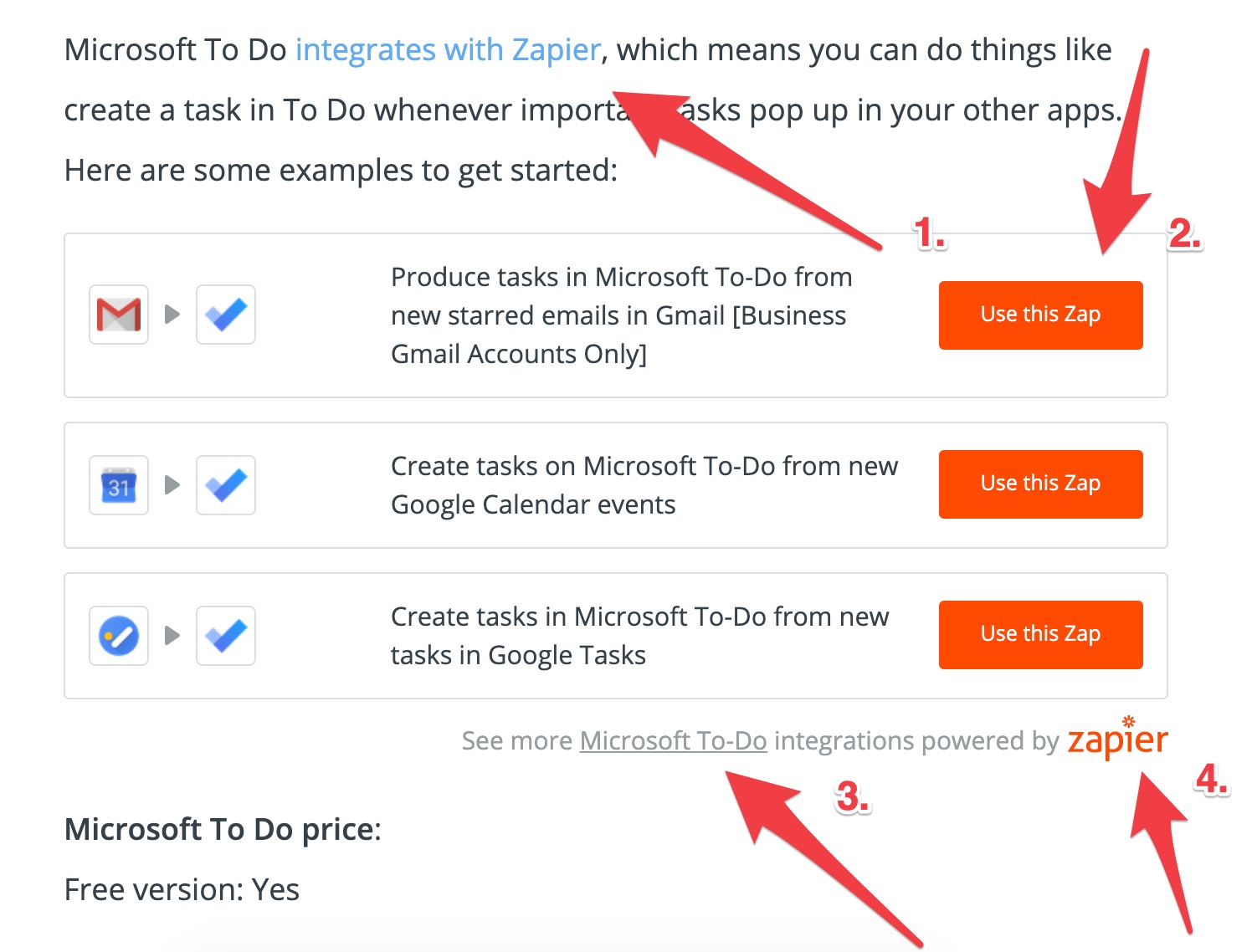
And Document360:
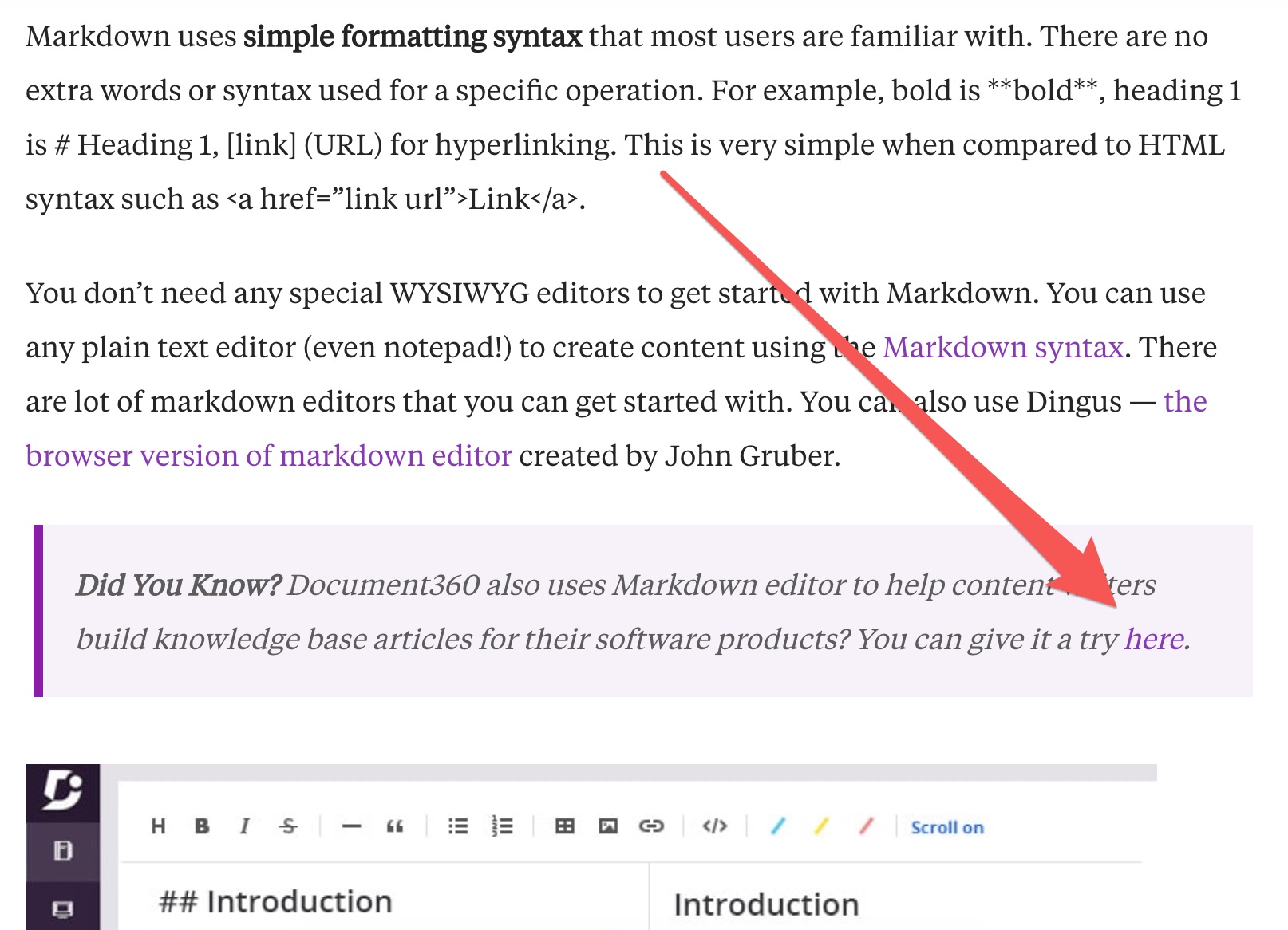
This is a form of native advertising. You invest in generating attention whilst creating the content and then aim to monetize through converting a certain number of visitors into free trials, demo’s and then ultimately customers.
So when defining you next SaaS content marketing strategy, be sure to understand that value you will provide for the audience, whilst also being aware of the value that you aim to capture for your business.
Balancing these two figures is the key to building a sustainable and profitable SaaS content strategy.
14 Awesome SaaS Marketing Case Studies
As you may or may not know… I’ve spent a large part of the last twelve month of my working life studying the growth of SaaS businesses and then detailing these in case studies shared on this very blog.
Why?
Because I believe that the single best way to learn how to grow a SaaS business is to understand what has and has not worked for other SaaS businesses and then look to replicate these strategies in your own business.
The case studies help you decide what to do… and then the learning comes from trying things yourself.
So we have collated the SaaS marketing case studies on this blog along with a number of others from around the internet to get you started.
1. Outreach, SEO & Partners – How Zapier Grew To $50m ARR Fully Remote
This case study shares:
- How Zapier used partners to grow exponentially
- The role remote working played in their growth
- The type of content that drives traffic but also conversions
2. SEMRush: The $100m Black Sheep Of SaaS
This case study shares:
- How SEMRush grew arguably the biggest SaaS affiliate program
- How outsource content marketing to influencers
- The right way to raise funding
3. ConvertKit: Nathan Barry’s Bumpy Road To $1.7m MRR
This case study shares:
- How Nathan Barry sold the majority of ConvertKit’s first customers
- The growth impact of a freemium model
- How ConvertKit’s niche has shifted over time
4. Bootstrapping To $25k MRR – The VEED Story

This case study shares:
- How Sabba still onboard every VEED user
- A sneaky Product Hunt “multi-launch” strategy
- How to test out of the box traffic sources
5. From Hackathon To $20k MRR – Document360 Grew Through SaaS SEO
This case study shares:
- Why Document360 started with SEO 12 months before releasing the product
- The importance of long term thinking in SaaS
- The Authority Podcast Funnel
6. Canva’s Growth Strategy: How they acquired 15,000,000 users
This case study shares how:
- Canva reached 2 million users within the first 2 years
- Canva effectively communicated their value proposition on landing pages
- To form the foundation of a world-class marketing and growth strategy
7. From Breakthrough Idea to Billion-Dollar Empire: 4 Secrets Behind Squarespace’s Extraordinary Growth
This case study shares how:
- Squarespace grew from a dorm-room idea into a billion-dollar company
- To prioritize long-term growth
- To build a company from the very beginning that is strategically aligned
8. How BuzzSumo Achieved $2.5m Annual Revenue in its First Year: Case Study in SaaS Growth
This case study shares how:
- Product matters more than marketing
- To be growth-focused
- To increase revenues by developing product
9. Behind the Scenes: How We’ve Built a $5M/Year Business in 3 Years With Content Marketing
This case study shares how:
- To understand what people actually want and how to deliver that in content
- To gain early traction
- Three key wins helped to drive traffic and get engagement through content
10. How This SaaS Startup Built a Conversion Funnel & Grew To 50,000 Customers
This case study shares how:
- To create a perception of uniqueness in the mind of a potential customer
- To position, your product that installs a belief that is “against” a mainstream idea
- Employees are not the only people who influence purchase decisions
11. 16 Steps Outreach.io Took To Build a $1.1 Billion SaaS Company
This case study shares how:
- To pivot to a product people actually want
- Outreach developed an extremely agile product release schedule
- To steal competitor traffic
12. How ClickFunnels Built a $100m Revenue Empire, $1 Billion+ Exit Feb 1st?
This case study shares how:
- To use your competition to inspire and build bigger and better products for the customer
- To use a cancellation funnel to fight churn
- To launch your own event and create a killer experience
13. HubSpot’s $271 Million Inbound Lead Generation Machine
This case study shares how:
- To create a powerhouse content partnership offering that your prospects can’t resist.
- Not to underestimate the power of communities and connecting your customers with each other
- To build a free software tool that can surface your customer’s core problems
14. Marketing Ideas from Intercom’s Multi-Million Dollar SaaS Growth Strategy
This case study shares how:
- To focus on high buy intent keywords if you want to be successful without a big ad budget
- To convert your traffic into customers
- To get all your content seen by a new audience
The 13 Best SaaS Marketing Podcasts To Subscribe To Now
Probably the biggest brand in SaaS. This is one of the top podcasts for all the SaaS companies. They interview the top and most prominent investors. Get tried and tested tips.
Build Your SaaS is unique. It’s following Jon and Justin as they actually build and grow a SaaS business.
Dan Martell will tell you how to hack your productivity in his podcast. You can find out how to scale, build, and sell your technology to the right audience.
Dylan Hey of Hey Digital brings on the people actually doing SaaS marketing from big names you have heard of and breaks down their specific SaaS growth strategies.
Actionable advice for bootstrapped SaaS founders from coaches and consultants about startup scaling challenges, building remote teams, leadership, getting unstuck, founder personal growth and more with Natalie Luneva.
Learn how to optimize your growth strategy for your SaaS startup from beta all the way to exit. We cover topics such as investing, acquisitions, leadership, B2B sales, growth marketing, scaling, hiring, conversion optimization, productivity, bootstrapping, venture capital, private equity and innovation with Akeel Jabber.
From our friends at SaaStock, founder Alex Theuma interviews leaders in the field of SaaS.
Omer Khan breaks down the growth of SaaS businesses at various stages in this long running SaaS podcast.
Nathan Latka breaks down the growth of 000’s of SaaS businesses in this top rated podcast. It’s not for the faint hearted.
Sunil Neurgaonkar interviews SaaS founders on India’s first SaaS focused podcast.
Paul Stephenson asks SaaS founders, CEOs, marketers and investors about the lessons they’ve learned in their quest to grow their companies.
The 4 Best SaaS Marketing Email Newsletters To Sign Up To
The SaaStr Weekly is a newsletter where you will get the best and latest updates. There are plenty of freebies and discounts on offer as well.
Inside SaaS sends out newsletters twice a week. You will get the latest and top news related to the industry.
A community of SaaS enthusiasts, The SaaS Playbook, is the newsletter that you should follow. You will get best practices, resources, and much more, which will help you enhance your business in no time.
A BEAST of a weekly roundup from the players over at ChartMogul, they handpick a few of the best SaaS articles from the week and distribute every Friday.
The 6 Best SaaS Marketing Blogs To Bookmark
The former VP of Growth @HubSpot… you will find high ‘essays’ to be of great value, a legend in the game.
You will find a variety of topics around marketing, sales, and growth on this blog by the Redpoint VC. All of the thoughts on the blog are backed up by proper data and statistics.
For Entrepreneurs by David Skok
This is the ideal SaaS marketing blog for start-ups that are looking to make a mark in the industry. David has a lot of knowledge and lessons to provide along with real-life examples.
Sixteen Ventures by Lincoln Murphy
Lincoln Murphy helps you figure out to retain clients, plan strategies, and expand effectively.
Follow SaaSX for sales, marketing, customer success, culture and liquidity best practices for founders and leaders of growing SaaS businesses.
A SaaS blog dedicated to finding the best SaaS apps, discovering inspiring SaaS stories, founders, and more.
7 SaaS Facebook Groups To Join
The biggest of the bunch with close to 20k members, this is a must join…
By the team at Poptin, SaaS Products & Marketing is a thriving community of product focussed SaaS marketers.
A group for SaaS founders run by Peter Loving.
Run by the team at Demio, is this group with the same name as their podcast.
Of course, we had to include this group that is JUST focused on the marketing of SaaS products.
From the team at SaaStock, this is a highly engaged community of people interested in SaaS.
Run by Dan Martell and his team, this group is just focused on helping SaaS founders.
13 SaaS Marketing Experts To Follow
The founder, as well as CEO of a renowned cloud company, Box, Aaron Levie aces at tech start-ups. He has built a strong social media presence and shares his experiences and tips in building a strong SaaS company.
Christoph Janz is a man with expertise in building and handling SaaS companies. Having a keen eye for the sector, he was an internet entrepreneur as well as an angel investor.
Dan Martell is popular across the globe as a coach who works with some of the topmost SaaS organizations. He is the co-founder of a successful venture, Clarity.
Brad Feld has ample experience in handling software and internet companies. For those looking for insights into the funding of technology start-ups, he’d be an excellent idol.
Being a founder of two companies, Userlist.io and Forget The Funnel, Claire Suellentrop has great insight into SaaS businesses. The SaaS specialist aids B2B software firms in attaining sustainable growth.
Danielle Morrill, the co-founder, and CEO of MatterMark enjoys helping clients dig into the data sources that can help them achieve growth.
David Skok started off early. At the age of 25, he was the founder of a total of four companies in the tech industry. With great experience in SaaS, cloud, mobility, marketing automation, David is definitely one to follow!
Dharmesh founded HubSpot in 2006 and, before that, was the founder and CEO of Pyramid Digital Solutions. He’s an angel investor in over 40 start-ups and, thus, a valuable expert to look up to.
Des Traynor is the co-founder of Intercom and Exceptional, two successful firms in the industry. His insights into the SaaS industry are highly valued.
David Cancel holds an excellent portfolio when it comes to managing sales and marketing firms. His expertise in the industry has helped many start-ups make a mark for themselves.
The Best 10 SaaS Marketing Agencies To Hire
A successful SEO and content marketing company that has assisted a number of multi-million dollar businesses, MRR Media, now focused on SaaS companies.
With clients such as HubSpot. This particular SaaS copywriter will understand your business and get you the desired result.
If you are looking to grow your SaaS start-up, this is the ideal company. The company was started by Asia and can help you with everything related to analyzing and growth.
Increase your ROI with reliable SaaS marketing services by HeyDigital. Focusing JUST on PPC advertising and landing page design, these guys clearly know how to generate results.
A full stop shop, Eduardo and the team have been in the SaaS game for years and can serve almost all of your SaaS marketing needs.
Partner with 42 for sales operations, demand generation, and account-based marketing.
Directive drives next-gen performance in its SaaS clients. They will lead remarkable and effective PPC and SEO campaigns to help your company grow.
A full-service B2B SaaS marketing agency that focusses on lead generation. The company specializes in growth with proper analysis and tactics.
One of the longest standing SaaS marketing agencies, Xander have been serving the great world of SaaS since 2009.
SimpleTiger is a SaaS marketing agency that helps start-ups grow exponentially. With their content marketing and SEO services, they focus on organic.
And there we have it…
The most comprehensive guide to SaaS marketing on the internet.
What did we do well?
What did we miss?
Hit us up in the comments and we’ll update this content based on your feedback 😉
But before we go, I have one more point to make…
As we said right at the start, the only way you are going to learn about and get better at SaaS marketing is by trying and failing at stuff. If I shared the amount of marketing attempts I have failed at over the past seven years, we would be here all day.
I’ve only been able to build up some kind of proficiency in this field because I have tried and failed at nearly every aspect of SaaS marketing.
So now it’s over to you.
What is the one thing you will take away from this post and implement next week, tomorrow or even… today?
Tom Hunt is the founder of SaaS Marketer and bCast (podcast hosting for marketers, by marketers). He lives and works in Hackney, London with his delightful partner Rebecca and little dog called Bear.


